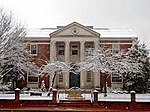Major General Nathanael Greene is a bronze equestrian statue honoring Nathanael Greene, a military leader during the American Revolutionary War. Greene was from modern-day Rhode Island and after laws passed by the Kingdom of Great Britain, along with the burning of one of his ships, Greene formed a state militia. He was later promoted to brigadier general in the Continental Army where he became a trusted adviser to Commander-in-Chief General George Washington. Greene played an active role during the war, participating in battles, sieges, and campaigns from New England to the Southern Colonies. For his service to the war, Greene was offered free land and settled in Georgia with his family. He died a few years later from a heatstroke.
Soon after the war concluded, the Congress of the Confederation passed a resolution to honor Greene with a memorial in the nation's capital. Nothing happened for almost 100 years until 1874 when Congress authorized $40,000 to be spent on an equestrian statue of Greene. A further $10,000 was allocated the following year for the pedestal. The sculptor chosen to create the statue, Henry Kirke Brown, had already made a statue of Greene that stands in the National Statuary Hall Collection. The pedestal was installed Christmas Eve 1877, and the statue was placed in position early the following year. The statue was well-received and is considered one of the best equestrian statues in Washington, D.C. It is located in the center of Stanton Park in the Capitol Hill neighborhood, a couple of blocks east of the U.S. Capitol.
A wind storm and corroded rivets resulted in the statue toppling over in 1930, but it was mostly unharmed. Greene's statue is one of 14 American Revolution Statuary in Washington, D.C., that were collectively listed on the National Register of Historic Places (NRHP) in 1978 and the District of Columbia Inventory of Historic Sites (DCIHS) the following year. In addition, the statue is a contributing property to the L'Enfant Plan and the Capitol Hill Historic District.










